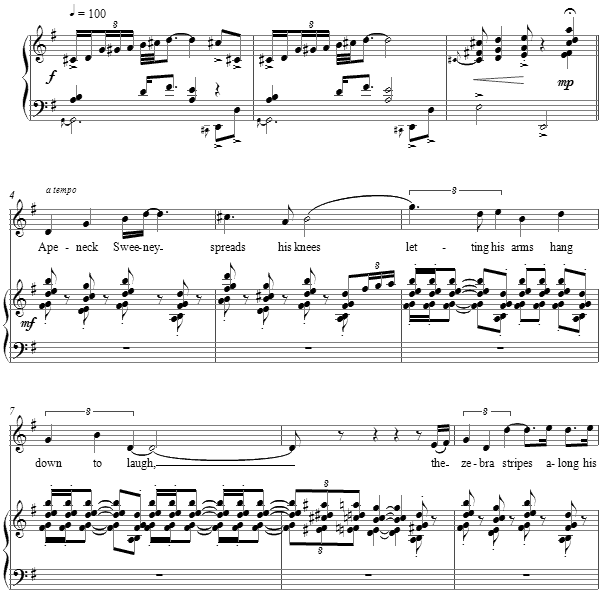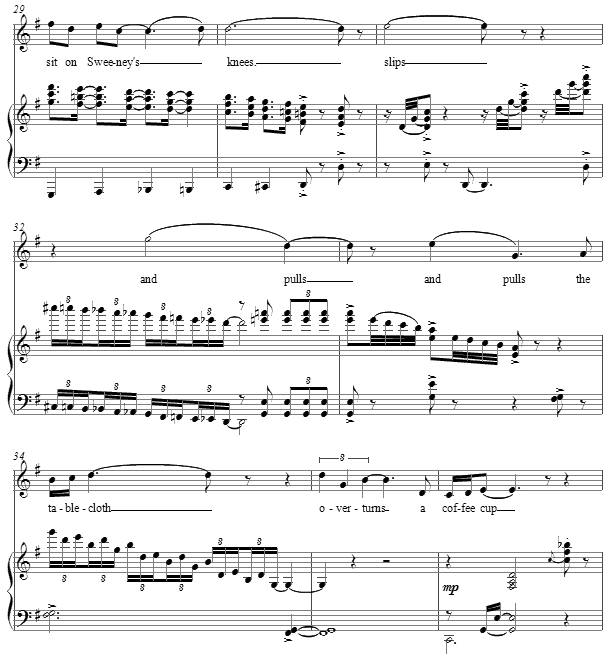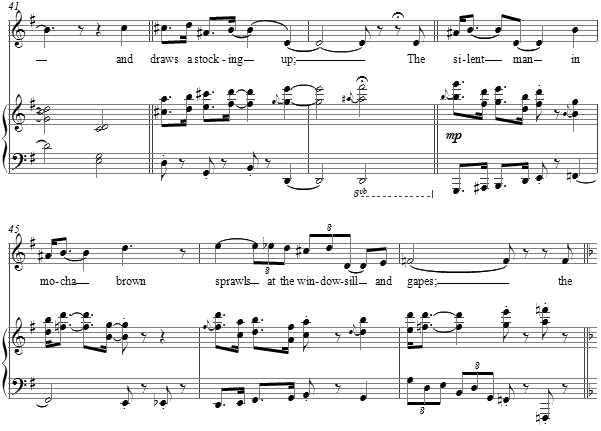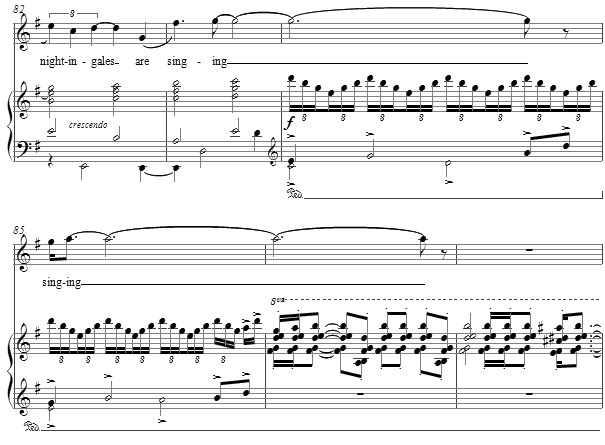Music and Texts of GARY BACHLUND
Vocal Music | Piano | Organ | Chamber Music | Orchestral | Articles and Commentary | Poems and Stories | Miscellany | FAQs
Sweeney Among the Nightingales - (2007)
T. S. Eliot
for soprano and piano
for Irina Popova
Apeneck Sweeney spreads his knees
Letting his arms hang down to laugh,
The zebra stripes along his jaw
Swelling to maculate giraffe.
The circles of the stormy moon
Slide westward toward the River Plate,
Death and the Raven drift above
And Sweeney guards the horned gate.
Gloomy Orion and the Dog
Are veiled; and hushed the shrunken seas;
The person in the Spanish cape
Tries to sit on Sweeney's knees
Slips and pulls the table cloth
Overturns a coffee-cup,
Reorganized upon the floor
She yawns and draws a stocking up;
The silent man in mocha brown
Sprawls at the window-sill and gapes;
The waiter brings in oranges
Bananas figs and hothouse grapes;
The silent vertebrate in brown
Contracts and concentrates, withdraws;
Rachel née Rabinovitch
Tears at the grapes with murderous paws;
She and the lady in the cape
Are suspect, thought to be in league;
Therefore the man with heavy eyes
Declines the gambit, shows fatigue,
Leaves the room and reappears
Outside the window, leaning in,
Branches of wisteria
Circumscribe a golden grin;
The host with someone indistinct
Converses at the door apart,
The nightingales are singing near
The Convent of the Sacred Heart,
And sang within the bloody wood
When Agamemnon cried aloud,
And let their liquid droppings fall
To stain the stiff dishonoured shroud.Duration 10 pages, circa 5' 30"
T. S. Eliot
Thomas Stearns Eliot (1888-1965) was born in St. Louis, Missouri, of an old New England family. He was educated at Harvard and did graduate work in philosophy at the Sorbonne, Harvard, and Merton College, Oxford. He settled in England, where he was for a time a schoolmaster and a bank clerk, and eventually literary editor for the publishing house Faber & Faber, of which he later became a director. He founded and, during the seventeen years of its publication (1922-1939), edited the exclusive and influential literary journal Criterion. In 1927, Eliot renounced his American citizenship and became a British citizen.
It has been said that Eliot has been one of the most daring innovators of twentieth-century poetry. Never compromising either with the public or indeed with language itself, he followed his belief that poetry should aim at a representation of the complexities of modern civilization in language and that such representation necessarily leads to difficult poetry.
For a poet of his stature, Eliot's poetic output was small. Eliot was aware of this early in his career. He wrote to J. H. Woods, one of his former Harvard professors, that "My reputation in London is built upon one small volume of verse, and is kept up by printing two or three more poems in a year. The only thing that matters is that these should be perfect in their kind, so that each should be an event." That output of poetry, of course, increased with time, but still remains small by comparison with many other poets. His Old Possum's Book of Practical Cats (1939) became a basis for the Lloyd Webber musical, CATS. "Old possum" was in fact a nickname given to Eliot by his friend, Ezra Pound. Best known for a more serious side, Eliot's The Love Song of J. Alfred Prufrock and The Waste Land established his reputation clearly.
Although many critics preferred his earlier work, Eliot and many other critics considered Four Quartets his masterpiece and it is the work which led to his receipt of the Nobel Prize. The Four Quartets draws upon his knowledge of mysticism and philosophy. It consists of four long poems, published separately: Burnt Norton (1936),
East Coker (1940), The Dry Salvages (1941) and Little Gidding (1942), each in five sections. Eliot was also a playwright, with his Murder in the Cathedral, about the death of Thomas Becket, being among the best known of several.
Drawn from the collection, Poems (New York Alfred A. Knopf 1920), this portrait "over time" of the effervescent Sweeney in a pub and, by the title, outside the pub near the Convent of the Sacred Heart, is replete with many characters, some anonymous and some named. In another poem from the same collection, "Sweeney Erect," Eliot calls for 'painting' a picture out of his words, and the author described there his character Sweeney as "broad bottomed, pink from nape to base" and this poem too tells us that Sweeney is often surrounded by women. This then is a portrait in music as well, rather than a story to be told. Just so, with Eliot's lengthier "Portrait of a Lady," in which tumbling and sometimes obscure visual, musical and cultural images populate his work.
The tessitura is broad, as is the style of the setting, with wide ranging gestures to capture to expanse of character as Eliot "paints" him. The opening gesture begins with that happy dissonance of the raised fourth of the scale, which dear Roy Travis, one of my professors at UCLA, liked to describe as the "indigestible tri-tone." If there is indigestion in this musical portrait of Sweeney, it is from too much drinking and perhaps too much of other "entertainments" as well. The accompaniment hints of the so-called Westminster chime, though buried into the chord form, and that chord form in its parallel placements and rhythms becomes the laughter of "apeneck" Sweeney, as the opening line declares him to be.
Several musical onomatopoeia declare the pratfall of the "person in the Spanish cape" who tries and fails to sit on Sweeney's knee. The embarrassment, such as it seems, is short-lived as the one more reflective moment of the "coffee cup" loosens the forward movement and tension of the previous gestures.
The necessity of drawing "a stocking up" lightens the mood, and a thematic syncopation follows in which other characters who surround and yet further define Sweeney by their nearness to him are introduced.
We find Sweeney outside the pub -- or other establishment -- and it is the nightingales which dominate the scene with their singing. The vocal line rises to its highest here and at the end of the setting as Sweeney's laughter breaks the song of the nightingales, as we see this broadly painted portrait of Eliot's Sweeney as the first and final focus of the scene.
The setting ends with a broad reprise of Sweeney's laughter in the accompaniment figure as the vocal line reprises the opening line of the poem itself.
Irina Popova
Irina Popova studied flute and voice at the Music Acadmy in Sofia. The Bulgarian was a 1995 winner of the International Belvedere Competition in Vienna. From 1996 through 2005 she was a member of the Lucerne Theater, and since the 2005-2006 season is a member of the ensemble in Theater Aachen, having sung such roles as Desdemona, Violetta and Ellen Orford. She was a delight with whom to work, and proved herself to be a fine singer and actress.
The score for Sweeney Among the Nightingales is available as a free PDF download, though any major commercial performance or recording of the work is prohibited without prior arrangement with the composer. Click on the graphic below for this piano-vocal score.
Sweeney Among the Nightingales





